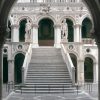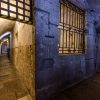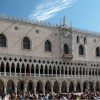A masterpiece of Gothic architecture, the Doge’s Palace is an impressive structure composed of layers of building elements and ornamentation, from its 14th and 15th century original foundations to the significant Renaissance and opulent Mannerist adjunctions.
The structure is made up of three large blocks, incorporating previous constructions.
The wing towards the St. Mark’s Basin is the oldest, rebuilt from 1340 onwards.
The wing towards St. Mark’s Square was built in its present form from 1424 onwards.
The canal-side wing, housing the Doge’s apartments and many government offices, dates from the Renaissance and was built between 1483 and 1565.
The origins. The first Doges
The first stable settlements in the lagoon probably came just after the fall of the Western Roman Empire (476). Gradually, these became more established and are considered as outposts of the Byzantine Empire. At the beginning of the 9th century, Venice enjoyed a reasonable level of independence. In 810, Doge Angelo Partecipazio moved the seat of government from the island of Malamocco to the area of Rivoalto (the present-day Rialto), when it was decided the Palazzo Ducale should be built, however, no trace remains of that 9th century building.
The Old Castle (10th-11th century)
It is probable that the Palazzo Ducale, being protected by a canal, stout walls and massive corner towers, was an agglomeration of different buildings destined to serve various purposes. Reached by a large fortified gateway where the Porta della Carta now stands, the buildings within these walls housed public offices, courtrooms, prisons, the Doge’s apartments, stables, armories, and other facilities.
Doge Ziani’s Palace (1172-1178)
In the 10th century, the Doge’s Palace was partially destroyed by a fire, and subsequent reconstruction works were undertaken at the behest of Doge Sebastiano Ziani (1172-1178). A great reformer, Doge Ziani radically changed the layout of the entire St. Mark’s Square area. Two new structures were built for his palace: one facing the Piazzetta – to house courts and legal institutions – and the other overlooking St. Mark’s Basin – to house government institutions. These new palaces probably had all the Byzantine-Venetian architecture characteristic features (such as the Fondaco dei Turchi, which today houses the Natural History Museum), but unfortunately, only few traces of this period remain (e.g. parts of the ground-level wall in Istrian stone and some herringbone-pattern brick pavement).
The 14th century palace
At the end of the 13th century it became necessary to extend the palace once more. Political changes in 1297 led to a significant increase in the number of people who had the right to participate in the legislative assembly meetings. The works, which would result in the building that we can see today, started around 1340 under Doge Bartolomeo Gradenigo (1339-1343) and concerned mostly the side of the palace facing the lagoon. In 1365, the Paduan artist Guariento was commissioned to decorate the east wall of the Great Council Chamber with a large fresco, while the room’s windows works were done by the Delle Masegne family. The Great Council met in this chamber for the first time in 1419.
Doge Francesco Foscari’s Renovations and the 15th century
Only in 1424, when Francesco Foscari was Doge (1423-1457), was it decided to continue the renovation works on the side of the building overlooking the Piazzetta San Marco. The new wing was designed as a continuation of that overlooking the lagoon: a ground-floor arcade on the outside, with open first-floor balconies running along the façade and the internal courtyard side of the wing. The vast Sala dello Scrutinio, formerly the Library, was built at the same floor as the Great Council Chamber, and its large windows and the pinnacled parapet took up the same decorative motifs as had been used previously. The Piazzeta’s façade was completed with the construction of the Porta della Carta, a work by Giovanni and Bartolomeo Bon. Works on the other wings of the Palace would not come until later. These would start with the construction of the Foscari entrance beyond the Porta della Carta, culminating in the Foscari Arch. This work was not completed until Doge Giovanni Mocenigo’s time (1478-1485).
The other wings of the Palace and the various fires in the building (1483-1574)
In 1483, a violent fire broke out in the canal-side of the Palace, which housed the Doge’s apartments. Once again, important reconstruction works became necessary and Antonio Rizzo was commissioned, introducing the new Renaissance architectural language to the building. An entirely new structure was raised alongside the canal, from the Ponte della Canonica to the Ponte della Paglia. Works were completed by 1510, and in the meantime Rizzo was replaced by Maestro Pietro Lombardo, who reviewed the decoration of the façade and of the Giants’ Staircase in the internal courtyard of the palace. In 1515, Antonio Abbondi, also known as Lo Scarpagnino, took over from Lombardo, finally completing the works by 1559. The 1565 erection of Sansovino’s two large marble statues of Mars and Neptune at the top of the Giants’ Staircase marked the end of this important phase. However, in 1574, another fire destroyed some of the second floor rooms, fortunately without undermining the structure. Works began immediately to replace the wood furnishings and decorations of these rooms. In 1577, when works had just been finished, another huge fire damaged the Sala dello Scrutinio and the Great Council Chamber, destroying masterpieces by artists such as Gentile da Fabriano, Pisanello, Alvise Vivarini, Carpaccio, Bellini, Pordenone and Titian. Reconstruction works were rapidly undertaken to restore it to its original appearance, completed by 1579-80.
The prisons and other 17th century works
Until then, the Doge’s Palace housed not only the Doge’s apartments, the seat of the government and the city’s courtrooms, but also a jail. It was only in the second half of the 16th century that Antonio da Ponte ordered the construction of new prisons, built by Antonio Contin around 1600, which were linked to the Doge’s Palace by the Bridge of Sighs. This transfer of the prisons left the old space on the ground floor of the palace free, and at the beginning of the 17th century works began to restructure the courtyard. A colonnade was created in the wing that houses the courtrooms similar to that of the Renaissance façade, while on the inner side a marble façade was constructed alongside the Foscari Arch, decorated with blind arches and surmounted by a clock (1615), a design by Bartolomeo Manopola.
The palace after the fall of the Venetian Republic
The Doge’s Palace was the heart of the political life and public administration of the Venetian Republic. Therefore, when the Republic fell in 1797, its role inevitably changed. Venice was firstly subjected to French rule, then to Austrian, and ultimately, in 1866, it became part of a united Italy. Over this period, the Palazzo Ducale was occupied by various administrative offices and housed important cultural institutions such as the Biblioteca Marciana (from 1811 to 1904). By the end of the 19th century, the structure was showing signs of decay and the Italian government set aside significant funds for an extensive restoration. Many original 14th century capitals were removed and substituted and the originals now form the collection in the Museo dell’Opera. All public offices were moved elsewhere, with the exception of the State Office for the Protection of Historical Monuments, which is still housed in the building, but under the current name of Superintendence of the Environmental and Architectural Heritage of Venice and its Lagoon. In 1923, the Italian State, owner of the building, appointed the City Council to manage it as a public museum. In 1996, the Doge’s Palace became part of the Civic Museums of Venice network.
_
![]() The Doge’s Palace – short version
The Doge’s Palace – short version
The history, the building, layout and collections, maps and general information










